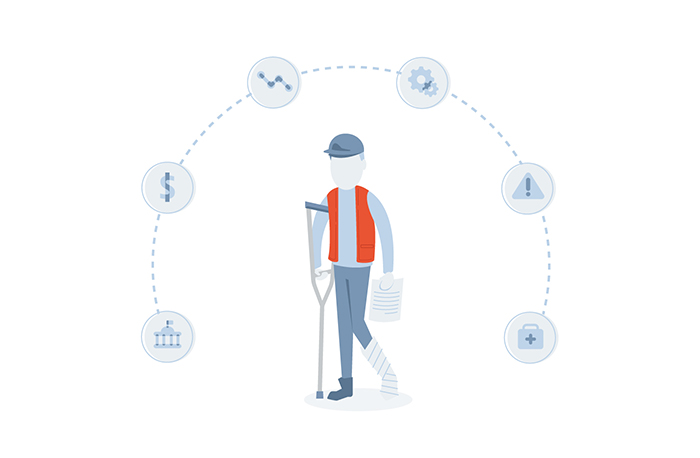Sponsored Content by York Risk
6 Ways a Single-Payer Model Could Impact Workers’ Compensation

A single-payer health care system — one in which a country’s health care costs are financed through taxes — has been embraced by countries like Canada, the UK, Australia and more. But in the U.S., the idea is still up for debate.
While there is no definitive solution yet, it’s an important topic to keep in mind. Workers’ compensation specifically could see a major industry-wide impact from a single-payer system, and starting that conversation now will help keep all the relevant stakeholders ahead of the curve.
“It’s critical that we talk about it,” said Thomas Warsop, chairman and CEO, York Risk.

Thomas Warsop, Chairman and CEO, York Risk
“It could certainly have a large impact on workers’ compensation, depending on how a single-payer model is implemented. We would need to figure out the pros and the cons. All of us who support injured workers, employers, regulators and providers have an obligation to help think through policy, implications and required preparations.”
Warsop, who has lived in a few of these countries with a single-payer model, including the UK, said that while he may not have a dog in the fight, he has a perspective on the benefits and pitfalls of a single-payer system.
Here are six ways a single-payer health care model could impact workers’ comp, and why it’s important for the industry to be prepared:
1. Medical Care Is Provided and Paid for Under a Single-Payer System, Regardless of the Genesis of the Need for Care
Today, there are millions of health care professionals across the U.S., with hundreds of payers and at least 52 sets of insurance regulations. Under a single-payer model, the payer would establish a standard for specific medical services and streamline the medical care portion of workers’ comp.
“There are a few elements to workers’ comp, and health care is clearly one of the main aspects,” said Warsop. “If you have an injury, you obviously need a well-functioning health care system to help get that injury treated appropriately.”
A single-payer model establishes a very specific cost-scale, equipping providers with a clear-cut fee schedule. The time spent on the medical bill review process would, theoretically, be reduced as well, making billing, payment and reconciliation much simpler.
This in turn allows providers to invest in providing great services and focusing on achieving better outcomes, because they know how much they will be paid.
 “A single payer also makes the medical side more straightforward for the injured worker, because they won’t have to worry as much about the determination of causality of an injury,” said Warsop. “Simply put, less time and money would be required to administer medical benefits.”
“A single payer also makes the medical side more straightforward for the injured worker, because they won’t have to worry as much about the determination of causality of an injury,” said Warsop. “Simply put, less time and money would be required to administer medical benefits.”
Employers, too, could see benefits. If their workers’ injuries are covered under the single-payer system, the workers will be guaranteed the care they need without having to worry about which system, traditional health insurance or workers’ compensation coverage, will pay for the medical treatment.
This approach may lead one to an obvious question: “If an employer has a reduced or less direct financial stake in the medical care of their injured workers, how will companies be held accountable for workplace incidents?”
As Warsop said, there are many elements to workers’ comp. Health care — or the medical portion — is one. Lost time, lost wages, determination of the cause of injury and return-to-work are also critical elements of a workers’ compensation claim, and employers will still need to be actively engaged in ensuring those benefits are delivered accurately and timely.
“And you would still have agencies like OSHA that are making sure employers provide a safe working environment and state regulators ensuring the timely and accurate delivery of benefits,” Warsop added.
2. Indemnity Could Be Even More Complicated
If medical care and costs are covered under a single-payer model there’s still the need to be thoughtful about the administration of all the other benefits available to an injured worker in the traditional workers’ compensation model.
“Medical care may be simplified for injured workers, but companies and employers would still have to sort through the administration of the non-medical benefits. And if physicians and other medical professionals don’t need to worry about ‘who is covering the event’ they may not spend much time, if any at all, thinking about is this a work-related incident,” said Warsop.
The workers’ comp industry is going to have to think creatively about the claims process and ensuring the right information is gathered early so that appropriate decisions around compensability and coverage are made early so as to provide for a great experience for all the stakeholders — injured workers, employers, etc.
3. There’s a Reduction in Overhead
“Today there’s a lot of effort and a lot of overhead that goes into determining whether an injury was sustained at work,” said Warsop.
He continued, saying workers’ comp professionals would have to work toward solutions that minimize the overhead from the non-health care portion of workers’ comp — the indemnity side — in order to see the benefits of a single-payer model.
“We could analyze the way workers’ comp gets paid, the way it gets administered,” said Warsop. “What are the key items that drive inefficiency or slowness, or maybe even hinder having the very best outcomes for injured workers?”
From there, knowing the key differences could lead to a way to make the process more consistent between states, which each currently have their own set of workers’ comp regulations.
“If state regulators are willing to look at the impact of a single-payer model, we could likely take a substantial amount of the overhead out of handling workers’ comp, even the non-medical part.”
4. Automation Is More Attainable
 In health care, there is a vast amount of data collected for each patient and procedure. Add workers’ comp into the mix and that data pool increases.
In health care, there is a vast amount of data collected for each patient and procedure. Add workers’ comp into the mix and that data pool increases.
“One of the biggest challenges in automating is that dizzying array of different pieces of data required by different stakeholders,” said Warsop.
A single-payer system could help, he said.
Taking payment questions out of the equation and centralizing data across health care, workers’ comp would lend itself to a more streamlined decision-making process — one that can more easily be automated.
“If you have a single-payer system, it would allow us and everybody in our industry to think broader about how we automate. How we make jobs easier to get better outcomes faster for injured workers.”
And once the data is in order, workers’ comp could see a huge difference in how claims are managed.
“With consistency in data structures, the industry can streamline the process for handling a workers’ comp claim. You can input the data about the cause of injury and know what the next steps will be, making the claims process easier from start to finish,” Warsop said.
Increased efficiency has the benefit of reducing claims management costs as well, taking out a reasonable amount of the cost of handling a workers’ compensation claim.
5. There’s an Opportunity to Focus on Safety
 Safety is at the heart of reducing workers’ comp claims frequency, and companies and their risk management teams have been investing in workplace safety for decades, from adding additional training sessions to implementing new technologies like exoskeletons or ergonomic desks.
Safety is at the heart of reducing workers’ comp claims frequency, and companies and their risk management teams have been investing in workplace safety for decades, from adding additional training sessions to implementing new technologies like exoskeletons or ergonomic desks.
But “if you think about the potential efficiencies of a single-payer model, you could invest even more in safety and drive frequency down faster, continuing to make the working world a safer place for workers,” said Warsop.
In that same vein, the nature of safety becomes a cyclical process: A safer workplace means less claims, less claims means less dollars spent, and less dollars spent means more available for future safety investment.
That’s the long-term trend to work toward, said Warsop.
“The efficiencies you could get from the single-payer model might continue to allow you to make safety-oriented processes even more efficient.”
6. Return to Work Can Apply to All Conditions, Not Just Workers’ Comp
 Under a single-payer model, no matter where or what the injury may be, a worker can receive the medical care they need to get back to work.
Under a single-payer model, no matter where or what the injury may be, a worker can receive the medical care they need to get back to work.
“The idea would be to view return-to-work programs as not solely under workers’ comp but under health care at large,” said Warsop. “Employers would be inclined to say ‘I don’t care whether you were hurt at work or not, your injury will still keep you out of work. Let’s get that fixed.’ ”
Regardless of how a worker was injured, the emphasis under a single-payer model would be on getting the person back to work.
Warsop cautioned, however, that this approach could put an added financial strain on the health care system, but “at the end of the day, we all want what’s best for our workers. We want to get people back to health and work no matter why they might be away from the job.”
Being Proactive Is a Must in a Changing Landscape
Regardless if a single-payer system ever does come into effect, Warsop said, it’s important that the industry has a seat at the table now and is part of the conversation. It has an opportunity to be engaged in and thinking about how these broader discussions of the nation’s health system could impact workers’ comp.
“Let’s be proactive. Let’s be part of the dialogue,” he said. “Right now, the workers’ comp industry tries to make as simple as possible a very complex set of interactions of regulation, of oversight, of risk bearers, of payers. We can help think through how to make it simpler.”
York is dedicated to finding those very outcomes that get injured workers back on their feet and to work. A one-size-fits-all solution doesn’t cut it, and the company works to stay current with the changing landscape.
“Under any model that exists, we’re going to continue to do our very best job in getting great outcomes and getting injured workers back on the job and back to health,” said Warsop.
Under a single-payer system, York is prepared to step up: “We would reallocate resources and expertise to areas where we can drive faster, better outcomes. At the end of the day, we’re trying to get people back to work,” said Warsop.
“That’s the mission of our company after all. We reduce risk and get people and organizations back to health, work and productivity.”
To learn more about York visit: https://www.yorkrisk.com.
This article was produced by the R&I Brand Studio, a unit of the advertising department of Risk & Insurance, in collaboration with York Risk. The editorial staff of Risk & Insurance had no role in its preparation.










